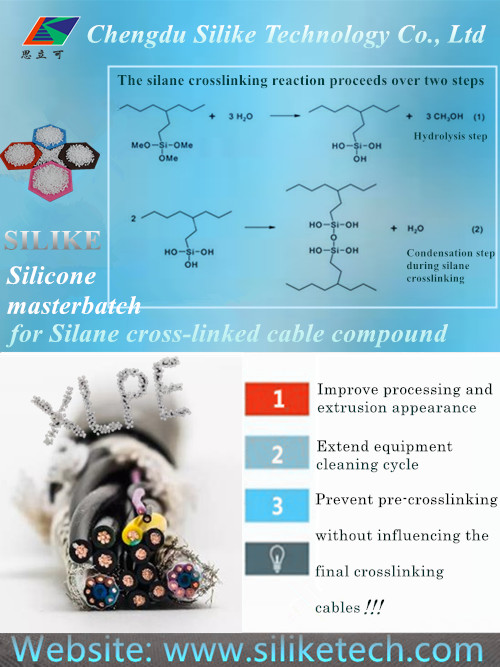SILIKE silicone masterbatch effectively prevents pre-crosslinking and improve smooth extrusion for XLPE Cable!
What is XLPE cable?
However, both peroxide and irradiation crosslinking techniques involve high investment costs. Other drawbacks are the risk of pre-curing and high production cost during peroxide crosslinking and the thickness limitation in radiation crosslinking. The silane crosslinking technique does not suffer from high investment costs and the ethylene-vinyl silane copolymer can be processed and shaped in conventional thermoplastic processing equipment and subsequently crosslinked after the processing steps. So, most wire and cable makers by Silane cross-linking tech to obtain their XLPE cable.
While, for the process of Silane cross-linking compounds, there’re 2 ways: one-step or two-step. For the One-step process, resins, catalyst( organic Tin), and additives like PE are mixed at a low velocity, then extruded into products; For the Two-step process, the catalyst(organic Tin) and additives are extruded into masterbatches in the first step, then they react with resins at the second step.
Cross-linked Polyethylene cable production issues
Usually, Silane-grafting will happen during the processing of Silane cross-linked cable compounds with some cross-linking reaction. If the lubricity of the resin is not good, the compounds easily adhere to the screw groove and mold dead corners and form dead materials which will affect the extruded cable appearance ( rough surface with little pre-crosslinking particles which formed at cross-linking step ).
How to prevent pre-crosslinking and improve smooth extrusion for XLPE Cable?
Chengdu Silike Technology is R&D, manufacturing, and trading combo silicone additives in XLPE/ HFFR cable compounds for more than 15+ years. Our silicone additives have been applied in cable compounds to promote processing & surface modification. they’re exported to SE Asia, Europe, America, etc.
When adding SILIKE silicone masterbatch into XLPE cable compounds, the unique property is able to prevent pre-crosslinking without influencing the final crosslinking cables. in addition, helps plasticizing, improves processing, like resin flow, less die-drool, the surface of wire and cable with smooth extrusion appearance, and extends the equipment cleaning cycle.
Post time: Nov-15-2022






